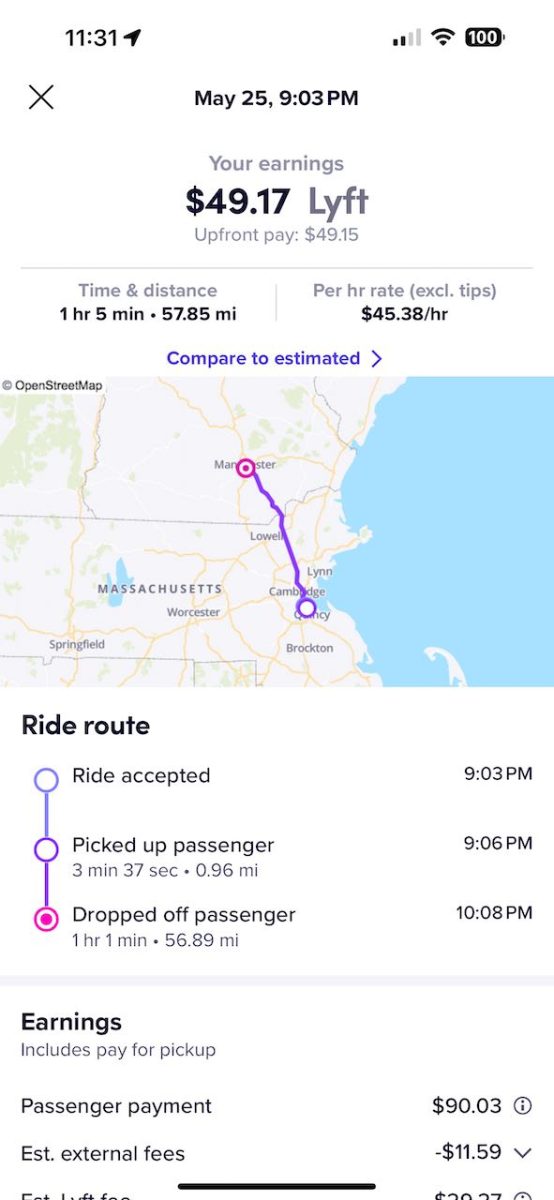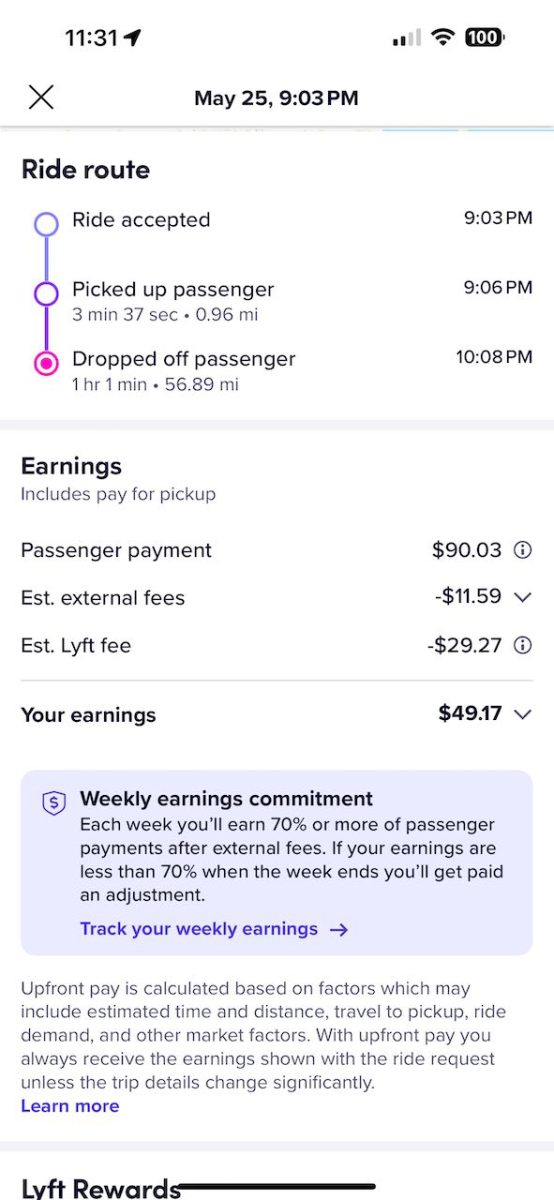Long rides are loser rides with Uber and Lyft. Here’s an example backed up with receipts.

This is a receipt from a Lyft ride from Quincy, MA to Manchester, NH. The driver was paid $49.17 while the customer paid $90.03. How does that happen? The business is not based on time and distance. There is no longer a rate card for either a driver or a customer to verify the cost. The customer will be charged as much as the rideshare company thinks they can get. The driver will be paid as little as the rideshare company thinks they can pay.

The second section of this receipt shows more detail. I’ll start by pointing out the light purple box at the bottom declaring the “Weekly earnings commitment” of 70% of passenger payments.
Let’s look at the numbers.
| Passenger payments | $90.03 |
| Est. external fees | $11.59 |
| Est. Lyft fee | $29.27 |
| Total earnings (gross revenue driver) | $49.17 |
| Tips | $0.00 |
| Tolls & other pass-throughs | $0.00 |
| Total earnings | $49.17 |
The passenger paid quite a bit more than the driver was paid but let’s consider the fees.
The “Est. external fees” are defined in the Lyft app as “Est. commercial auto insurance & other expenses”. It’s also defined elsewhere as “External fees include commercial auto insurance coverage, taxes, government fees, and other expenses such as payment processing fees.”
The “Est. Lyft fee” is defined as “Lyft’s fee is the amount retained by Lyft and is used to maintain the platform. Part of Lyft’s fee is invested in drivers and app improvements that improve their experience with Lyft.”
The Total earnings were $49.17. No tips, no tolls. However that accounts for only 54.62% of the total paid by the passenger.
| Percent to driver | 54.62% |
| Percent to company | 45.38% |
Let’s look at the time and distance. Here’s where it gets interesting.
| Total miles to drop-off | 57.85 |
| Total miles return | 61 |
| Total miles | 118.85 |
| Total time drop-off | 1.1 |
| Total time to return | 1.1 |
| Total time | 2.2 |
It was 57.85 miles to the drop-off from Quincy, MA and then it was 61 miles to get home for a total of 118.85 miles. You can see that the drop-off time was 10:08pm in New Hampshire where the drive is not allowed to work. Given that and the time it only made sense to end the shift.
The drive time in both directions was 1.1 hours or 2.2 hours total.
| IRS deduction @$.67/mile | $79.63 |
Subtracting the mileage expense from the Total Earnings of $49.17 yields a loss of $30.46.
| Real Net Income or Loss | -$30.46 |
Not only did the mileage expense wipe out all of the Total Earnings for this ride there is a loss of $30.46 that can be applied against the earnings of other rides. This reduces the driver’s tax liability.
Why use the IRS mileage deduction?
Lyft 70% Guarantee
So now we introduce another method of calculating earnings. The Lyft 70% Guarantee. From the purple box in the above image it states: Each week you’ll earn 70% or more of passenger payments after external fees. If your earnings are less than 70% when the week ends you’ll get paid an adjustment.
| Lyft 70% guarantee | $54.91 |
| Lyft 70% guarantee net IRS | -$24.72 |
| Lyft 70% guarantee net IRS hourly | -$22.47 |
This first item is the Passenger Payment of $90.03 less the Est. external fee of $11.59 which gives us $78.44. We take 70% of that to get $54.91. Subtract the mileage expense from $54.91 to get the loss of $24.72. Divide this number by the time to drive to the dropoff (1.1 hours) to get the hourly rate of a loss of $22.47.
MA Attorney General’s Settlement
Here’s yet another way of calculating driver’s pay. You can read the FAQs about it in this link: https://www.mass.gov/info-details/uber-and-lyft-settlement-information-and-frequently-asked-questions
The problem with this is that it’s a 2 week average and it’s based on “Engaged time”. You can see from this example that engaged time is only about half of the total time. This particular job will be averaged into 2 weeks worth of jobs. In this case it works out for Lyft as the driver made $49.17 in a little over 1 hour. The problem is the dead miles after and that is the driver’s problem.

Leave a Reply